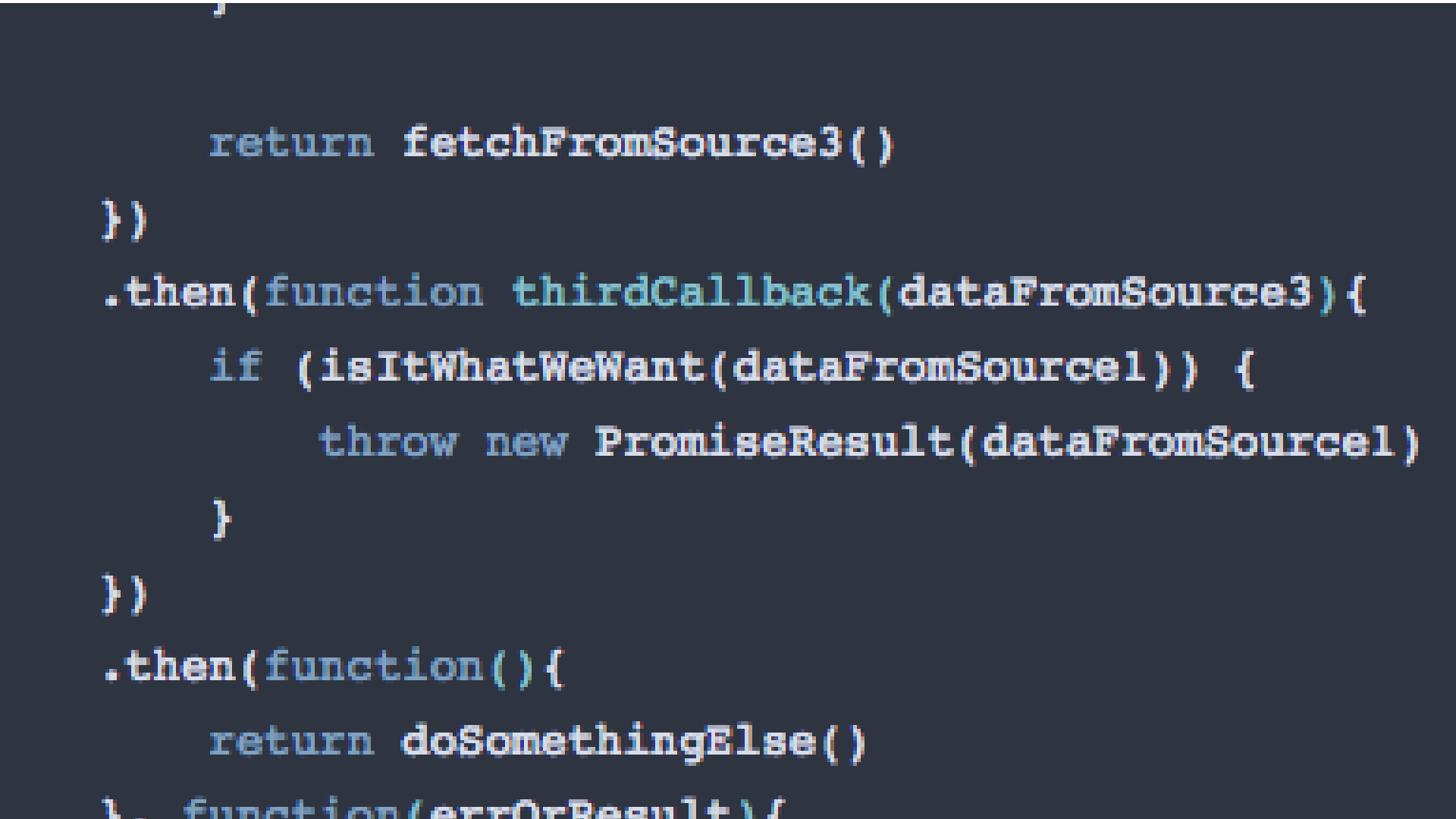Promise pattern - Breakable then() chain
\ January 28, 2019 +00:00 \Recently I realised that I used quite a few repetitive coding patterns that meant to solve certain problems with Promise involved. I think it would be nice to write them down here, as it will be useful to my future self or potentially anyone who is facing the same problem as I did.

I think it would be even nicer to make these patterns into a promise-belt utility library but I don't have time to fully go through it yet... so here we go:
TLDR: Use throw PromiseResult(result) to break a promise then callback chain, is much easier than checking the resolved value in each then callback.
Breakable then callback chain
One virtue of promise() is it allows you to keep chaining async calls with infinite then() functions, this is very useful as it helps to avoid writing deeply nested callbacks, it makes the business logic much pleasant to look at.
For example, it is quite often for me to do something like this: fetch data from source 1, if it is what we want then do postProcess(data), if not, try fetch data from source 2 and check again if that is what we want, if it is, do postProcess(data) as always and so on and on...
it often ends up with code like this:
fetchFromSource1()
.then(function(dataFromSource1){
if (isItWhatWeWant(dataFromSource1)) {
return postProcess(dataFromSource1)
}
return fetchFromSource2()
.then(function(dataFromSource2){
if (isItWhatWeWant(dataFromSource2)) {
return postProcess(dataFromSource2)
}
return fetchFromSource3()
.then(function(dataFromSource3){
if (isItWhatWeWant(dataFromSource3)) {
return postProcess(dataFromSource2)
}
return doSomethingElse()
})
})
})
As you can see from above, as the number of data source increase, the code gradually developed into some deeply nested callback hell, it is not just unpleasant to look at, it is also very difficult to understand the logic and you need a very wide screen to see the whole piece of code 🤦.
So I wanted to pull out those nested blocks above by using then callback chain to flatten the whole piece, and it goes well at the beginning:
Promise
.resolve()
.then(function(){
return fetchFromSource1();
})
.then(function firstCallback(dataFromSource1){
if (isItWhatWeWant(dataFromSource1)) {
return postProcess(dataFromSource1)
}
return fetchFromSource2()
})
.then(function secondCallback(dataFromSource2){
if (isItWhatWeWant(dataFromSource2)) {
return postProcess(dataFromSource2)
}
return fetchFromSource3()
})
.then(function thirdCallback(dataFromSource3){
if (isItWhatWeWant(dataFromSource3)) {
return postProcess(dataFromSource2)
}
return doSomethingElse()
})
It looks much better now except it DOES NOT work.
If dataFromSource1 is the data we want, the postProcess() will return a resolved promise, which causes secondCallback() and postProcess() to be called again, so does the thirdCallback().
So in order to make it works, the most straight forward solution is to make postProcess() return a special object and check that object in each callback to avoid unnecessary processing, here is the updated code:
const abort = {};
function postProcess(data) {
...
return abort;
}
Promise
.resolve()
.then(function(){
return fetchFromSource1();
})
.then(function firstCallback(dataFromSource1){
if (isItWhatWeWant(dataFromSource1)) {
return postProcess(dataFromSource1)
}
return fetchFromSource2()
})
.then(function secondCallback(dataFromSource2){
if (dataFromSource2 === abort) {
return abort;
}
if (isItWhatWeWant(dataFromSource2)) {
return postProcess(dataFromSource2)
}
return fetchFromSource3()
})
.then(function thirdCallback(dataFromSource3){
if (dataFromSource2 === abort) {
return abort;
}
if (isItWhatWeWant(dataFromSource3)) {
return postProcess(dataFromSource2)
}
return doSomethingElse()
})
This time it is working, and it is much friendly to the eyes, but it does come with a downside: for every callback the dev needs to remember checking the resolved value against abort object. It is error prone, and later joined devs might not notice that they need to do so.
To make the code less error prone. The pattern I usually use in the project does the opposite, rather than checking the abort object in every callback, it throws or reject a PromiseResult object, which is the holder of the true resolved value. This way we can use early rejection to skip the callback and process the data at the end of the callback chain:
function PromiseResult(result) {
this.result = result;
}
Promise
.resolve()
.then(function(){
return fetchFromSource1();
})
.then(function firstCallback(dataFromSource1){
if (isItWhatWeWant(dataFromSource1)) {
throw new PromiseResult(dataFromSource1)
}
return fetchFromSource2()
})
.then(function secondCallback(dataFromSource2){
if (isItWhatWeWant(dataFromSource1)) {
throw new PromiseResult(dataFromSource1)
}
return fetchFromSource3()
})
.then(function thirdCallback(dataFromSource3){
if (isItWhatWeWant(dataFromSource1)) {
throw new PromiseResult(dataFromSource1)
}
})
.then(function(){
return doSomethingElse()
}, function(errOrResult){
if (errOrResult instanceof PromiseResult) {
return postProcess(errOrResult.result)
}
throw errOrResult
});
Now that is much better, I know some of you might not like the bits where it throws, as it comes with performance penalties, but you can always substitute them into return Promise.reject.